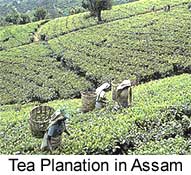 Assam is a state in northeastern India, in the low-lying Brahmaputra Valley. Assam has international borders to the north with Bhutan and to the southwest with Bangladesh.
Assam is a state in northeastern India, in the low-lying Brahmaputra Valley. Assam has international borders to the north with Bhutan and to the southwest with Bangladesh.
Also to its north and east lies Arunachal Pradesh. Assam shares a border with four hill states-Nagaland and Manipur to the east, and Mizoram and Tripura to the south. It has a further short stretch of border with Bangladesh between Tripura and Meghalaya, which borders Assam to its southwest.
Climate:
Assam is the largest and most highly populated state in the region. Assam is famous for its tea. The game reserves at Kaziranga and Manas are also well known.
Assam occupies the long narrow floor of the Brahmaputra Valley. It is overshadowed by the Himalaya to the north and the Shillong Plateau to the south. The valley floor, even in the shelter of the Shillong Plateau, still receives heavy rainfall during the monsoon season of June to October. Rainfall varies between about 180 centimetres and 250 centimetres. Temperatures along the valley rarely drop below 10 °C, the average minimum temperature for January. Average minimum temperatures rise to 26 °C in July and August. Average maximum temperatures are 23 °C in January, rising to 32 °C in April and again from June to August. Total rainfall varies from between 180 centimetres to 250 centimetres, but throughout the valley it is heavily concentrated in the summer monsoon. On average, less than 4 centimetres fall from November to March.
Tourist Centres:
Guwahati-Kaziranga-Sibsagar and Guwahati-Manas are two travel circuits promoted by the Union Government. The following additional circuits have been proposed by the state.
- Guwahati-Bhairabkunda-Orang-Bhaluking-Tezpur.
- Guwahati-Diphu-Haflong-Silchar.
These circuits can be linked with Arunachal, Mizoram and Manipur.
Kaziranga National park is world famous for rhinos and elephants. Manas is another National park.
Foreigners visiting the state have to obtain restricted area permits from the Union Home Ministry.
History of Assam......
| 


